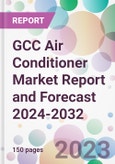The GCC, comprising six Middle East countries, namely, Bahrain, Kuwait, Oman, Qatar, Saudi Arabia, and the United Arab Emirates, is known for its extremely hot and arid climate. Air conditioners, therefore, play a crucial role in maintaining indoor temperature and air quality, making them an indispensable part of residential, commercial, and industrial buildings in the region.
The burgeoning demand for effective cooling solutions, primarily triggered by the region's climatic conditions, is a significant driver propelling the GCC air conditioner market growth. With escalating temperatures, the requirement for energy-efficient and high-performing air conditioners is witnessing a surge, enhancing the market growth. Furthermore, the increasing health awareness among consumers about the importance of indoor air quality has reinforced the necessity for advanced air conditioners.
The expanding residential and commercial infrastructure is another prominent factor bolstering the GCC air conditioner market demand. The region is undergoing rapid urbanisation and infrastructural development, with several construction projects underway in sectors like hospitality, healthcare, retail, and real estate. The expansion of these sectors directly translates to a heightened demand for air conditioners, thus fuelling the market growth.
Moreover, the applications of air conditioners are not limited to temperature regulation but also extend to air purification, dehumidification, and ventilation. These additional features have rendered air conditioners vital in various sectors, including healthcare and industrial processes, thereby boosting the market expansion.
Looking ahead, the push for eco-friendly and energy-efficient cooling solutions in line with global sustainability efforts is expected to create fertile ground for innovation and market expansion. The emergence of smart air conditioners integrated with IoT technology and AI, allowing remote access, energy management, and predictive maintenance, aligns with the modern consumer's preference for convenience and efficiency, thus heralding promising prospects for the GCC air conditioner market outlook.
Market Segmentation
The market can be divided based on type, end use, and country.
Market Breakup by Type
- Window AC
- Split AC
- Packaged AC
- Ducted Split AC
- Cassette AC
- Floor Standing AC
- Centralised AC
Market Breakup by End Use
- Residential
- Commercial and Retail
- Healthcare
- Hospitality
- Government and Transportation
- Industrial
Market Breakup by Country
- Saudi Arabia
- United Arab Emirates
- Oman
- Qatar
- Kuwait
- Bahrain
Competitive Landscape
The report looks into the market shares, plant turnarounds, capacities, investments, and mergers and acquisitions, among other major developments, of the leading companies operating in the GCC air conditioner market. Some of the major players explored in the report are as follows:- Carrier Global Corporation
- Daikin Industries, Ltd.
- Mitsubishi Electric Corporation
- LG Electronics Inc.
- Fujitsu General Limited
- Toshiba Corporation
- Trane Technologies Company, LLC
- YORK
- GREE Comfort
- Zamil Air Conditioner
- S.K.M. Air Conditioning LLC
- Awal Gulf Manufacturing Co.
- Others
Table of Contents
Companies Mentioned
- Carrier Global Corporation
- Daikin Industries Ltd.
- Mitsubishi Electric Corporation
- LG Electronics Inc.
- Fujitsu General Limited
- Toshiba Corporation
- Trane Technologies Company LLC
- YORK
- GREE Comfort
- Zamil Air Conditioner
- S.K.M. Air Conditioning LLC
- Awal Gulf Manufacturing Co.
Methodology

LOADING...








